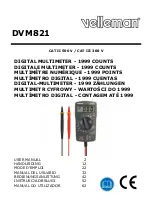
DVM821
V. 03
–
20/03/2020
9
©Velleman nv
Use extreme caution when measuring voltages higher than 60 VDC
or 30 VAC rms.
Always place your fingers behind the protective edges of the test
probes while measuring!
10.1
DC VOLTAGE MEASUREMENT
1.
Set the rotary switch in the desired V
position. If the voltage to be
measured is unknown beforehand, you should set the range switch in
the highest range position and then reduce gradually until the ideal
resolution is obtained.
2.
Connect the test leads to the source being measured.
3.
Read the voltage value on the LCD display along with the polarity of
the red lead connection.
10.2
AC VOLTAGE MEASUREMENT
1.
Set the rotary switch in the appropriate V~ position.
2.
Connect the test leads to the source to be measured.
3.
Read the voltage value on the LCD display.
Notes
•
If the range is not known beforehand, set the selector switch to a high
range and lower gradually.
•
An
OVER-RANGE
is indicated by
1
or
-1
. Set to a higher range.
•
The maximum input voltage is 500 V rms.
11.
Current Measurement
Do not measure circuits that may contain voltages > 500 V
Use extreme caution when measuring voltages higher than 60 VDC
or 30 VAC rms.
Always place your fingers behind the protective edges of the test
probes while measuring!
1.
Set the rotary switch (DCA) in the desired position.
2.
Open the circuit in which the current is to be measured and connect
the test leads to the circuit
IN SERIES
.
3.
Read the current value and the polarity of the red lead connection on
the LCD display.
Notes
•
If the range is not known beforehand, set the selector switch to a high
range and lower gradually.
•
An
OVER-RANGE
is indicated by
1
or
-1
. Set to a higher range.










































